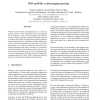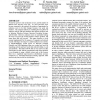275 search results - page 36 / 55 » Self-Organization in Peer-to-Peer Systems |
SASO
2009
IEEE
14 years 5 months ago
2009
IEEE
—Controlling particle swarm optimization is typically an unintuitive task, involving a process of adjusting low-level parameters of the system that often do not have obvious corr...
SASO
2008
IEEE
14 years 5 months ago
2008
IEEE
Wireless sensor networks are designed for a very wide, yet specific, purpose. Their components have processing and power limitations. Due to these limitations, decisions by runni...
DCAI
2008
14 years 21 days ago
2008
. In this paper, a forecasting system is presented. It predicts the presence of oil slicks in a certain area of the open sea after an oil spill using Case-Based Reasoning methodolo...
ACMSE
2006
ACM
14 years 27 days ago
2006
ACM
Society has grown to rely on Internet services, and the number of Internet users increases every day. As more and more users become connected to the network, the window of opportu...
SASO
2009
IEEE
14 years 5 months ago
2009
IEEE
Abstract—Unstructured peer-to-peer networks can be extremely flexible, but, because of size, complexity, and high variability in peers’ capacity and reliability, it is a conti...


